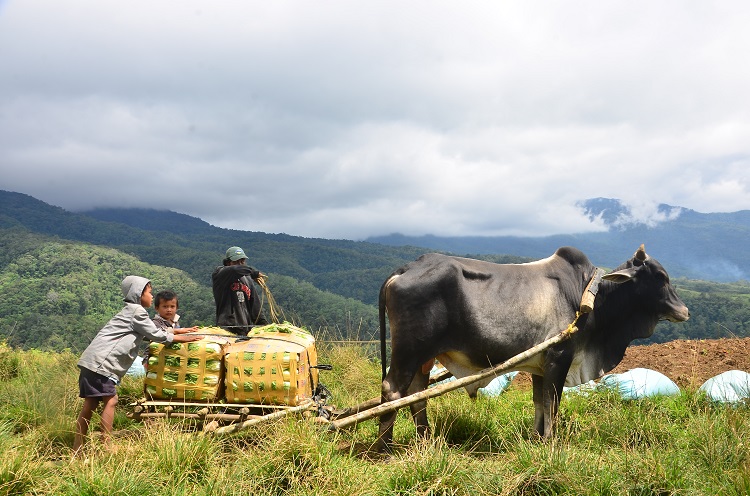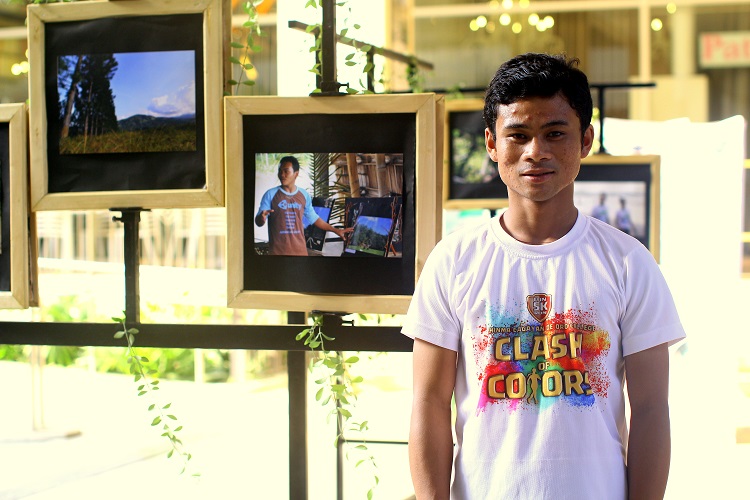
INTERCONNECTED LANDSCAPE. With the company of two kids, a farmer uses a makeshift cart attached to a cattle to haul their agricultural produce to the market. Miarayon is a lumad community nestled at the foot of Mt Kalatungan, one of Bukidnon’s prized giants and twin of Mt Kitanglad. Cagayan de Oro City acts as the catchment basin of the Northern Mindanao’s upstream bodies of water, and serves to gain from the protection of Mt Kalatungan. Being the catch basin of the waters from the hinterlands of Bukidnon, riverbank communities of CDO would bear massive casualties and significant damage to property during strong typhoons. Photo by Chum Magdadaro.
Words by Stephen J Pedroza
Age doesn’t matter when it comes to environmental protection and conservation.
For a lumad youth from the Talaandig tribe in Bukidnon, Jossie “Josa” Rey Samontao, everyone has a role to portray if we are to sustainably manage our natural resources for the present and future generations.
“The interconnectedness of Mt Kalatungan in Talakag, Bukidnon and Cagayan de Oro river basin is very important to all of us, not just among the lumads,” he says in combined English and Bisaya. “What happens here in the city affects our livelihood in the highlands. For example, when there is a calamity in CDO, our agricultural products don’t get delivered. They end up stored in our farm houses until they spoil,” he explains.
Josa was one of the 30 participants of the recently concluded Ridge-to-Reef Young Leaders Camp (R2RYLC), a youth camp that brought together millennials from resettlement and riverside barangays of Cagayan de Oro City and lumad communities in Bukidnon towards sustainable resource management and raising environmental awareness in their communities.
Protecting what you love
As a member of the Talaandig tribe, 21-year-old Josa believes that taking good care of the forests is imbued in their culture and identity as the people of Mt Kalatungan, one of Bukidnon’s prized giants and twin of Mt Kitanglad.
“In our culture, we have a deep connection with Kinaiyahan (Mother Nature) and we take it as an important role to protect the forests,” he says, adding, “We believe that the forest is the home of spirits that protect us.”
As his hugot from the camp, the colorful Josa quips, “If you truly believe and love something, you always protect it no matter what.”
Young environment champions like Josa presented their green initiatives from the Ridge-to-Reef Camp through a photo exhibit and concert on March 5 at Centrio – Ayala Mall in CDO.
Josa and his team came up with the Sea to Summit Project after undergoing workshops to enhance their knowledge in grassroots planning, local land governance, ecosystem conservation, and ideation for their information, education and communication (IEC) projects.
Josa’s team actively participated in the greening project initiative of the local government of Opol, a coastal municipality in Misamis Oriental, to conduct a forum on climate change in various barangays and school campuses, as well as to join the clean-up and mangrove-planting activities.
They were able to collect 18 big bags of garbage from their clean-up drives and they planted more than 500 mangroves along the shore.
“I joined this camp because I wanted to share what I know about conservation and protecting our environment,” Josa recounts. “I have observed that storms are frequenting Mindanao in the past few years and we need to do something in our own ways to minimize the risks before causalities happen and people die.”
Cagayan de Oro City acts as the catchment basin of the Northern Mindanao’s upstream bodies of water, and serves to gain from the protection of Mt Kalatungan. Being the catch basin of the waters from the hinterlands of Bukidnon, riverbank communities of CDO would bear massive casualties and significant damage to property during strong typhoons.
YOUNG LUMAD LEADER. For a lumad youth leader from the Talaandig tribe in Bukidnon, Jossie “Josa” Rey Samontao, everyone has a role to portray if we are to sustainably manage our natural resources for the present and future generations. “In our culture, we have a deep connection with Kinaiyahan (Mother Nature) and we take it as an important role to protect the forests.” Photo by Jan Michael Amper.
Youth projects
The green projects of the youth groups were based on their own contexts and issues close to their communities. Among the projects showcased at the said exhibit were Take a Selfie with Mother Earth (TASME), Sea to Summit, Bitan-ag's Sustainability and Rehabilitation (B-SURE), Youth Stewards of Nature, Culture for Nature, and Bantula.
“This exhibit showcases everything that has transpired in R2RYLC, from our 6-day intensive camp in Miarayon, where the campers learned about servant leadership, had their community exposures and gained technical inputs from ridge-to-reef [environmental restoration] experts, up to the point of implementation of their brainchild environmental initiatives,” says Xyla Mercedita Gualberto, the project coordinator of the camp.
“It shows not only the outcomes, but as well as the process,” she adds. “I realized that the today’s youth are very active, creative and involved. They are very powerful people who can undoubtedly contribute to the solutions of one of the most complex issues we are facing today, and that is environmental degradation.”
Not purely theoretical but more experiential, “The campers went to the very places where the water flows, from the mountains, to the rivers down to the Macajalar Bay,” says Gualberto, who derived the concept of the training from the participatory zoning course of Xavier Science Foundation’s Institute of Land Governance.
“Working with 30 young people coming from diverse backgrounds, I have seen that they have one thing in common: They are genuine in wanting to change the word one step at a time. They have the energy and the willingness to work for what they want.”
Gualberto said that the youth need further support from different institutions to empower them. “We just need to believe in them, to equip them and give them avenues where they can bring their brilliant ideas to life,” she says.
Each youth group was allotted with a small grant from Smart Telecommunications Inc to execute their projects in their respective communities.
The US Embassy in Manila also supported the project through its Young Southeast Asian Leaders Initiative (YSEALI) Seeds for the Future Grant Competition where R2RYLC is one of the 18 winning projects across the ASEAN region, tackling Southeast Asia’s challenges on education, environmental protection, civic engagement, and economic development.
“We will continue to tap more partners who will work with us in raising a new breed of environmental champions. We were surprised to learn that there are so many people and organizations from the academe, government, NGOs and private sectors who want to be a part of what we’re doing,” Gualberto says.
“We will definitely be collaborating with them to keep the campers’ initiatives going. The problem we’re facing is so big; we need all the hands and hearts we can get.”
BEFORE THE OPENING. Young environment champions presented their green initiatives from the Ridge-to-Reef Young Leaders Camp through a photo exhibit from March 3 to 5 at Centrio – Ayala Mall in CDO. Photo by Jan Michael Amper.
Partnering with local communities
Ridge-to-Reef Camp project supervisor Evans Yonson sees the partnerships at the local level as crucial to the sustainability of the green initiatives of the young leaders.
“The six projects developed and implemented by the campers have established partnerships at the local level. We made sure during the camp that their projects were done at a familiar locale,” Yonson remarks.
“So far, the responses of the local partners have been very encouraging. For us, it's a welcome relief that after all, our efforts are paying off as early as now.”
There is more to the compelling photos and posters displayed at the exhibit or their musical tribute to Mother Nature. This Ridge-to-Reef Young Leaders Camp has opened doors to young people like Josa to contribute in a region-wide environmental crusade and most especially, to represent a struggling culture in the face of modernization.
Being one of the few high school graduates from Miarayon to pursue college, Josa is grateful for the opportunity to inspire his fellow youth in the highlands.
Now a first-year education student of Cagayan de Oro College – PHINMA Education Network, he is adjusting to the bustling city life while keeping the pride and tradition as a lumad alive wherever he goes.
“My greatest realization from this camp is the appreciation of the interconnectedness of the uplands and the downstream in our region. I still have many what-ifs: What if the mountains remain bald? What if the forests keep on getting thinner and thinner? What if there is mining in the area and the wastes go down the river? What if there is another [Typhoon] Sendong?”
For Josa and other young environment champions from the camp, protecting the environment doesn’t have to be a daunting undertaking — many small things make up a collective impact.
“It might sound repetitive but this is our common home, and you and I have the responsibility to take good care of it,” Josa says as a challenge to his fellow millennials.
“And we can start while we are still young.”
(The Ridge-to-Reef Young Leaders Camp was supported by the Young Southeast Asian Leaders Initiative, Smart Telecommunications Inc, Centrio - Ayala Mall, Habagat, Steag State Power Inc, Kagay White Water Rafting, Bigby’s, Boy Zugba, Cagayan de Oro Water District, Xavier Science Foundation, Xavier University - Development Communication Society, XU College of Agriculture, Kuya Fish Campaign, Crux Design Studio, Valuing Ecosystem Services Together and BringMeVeggie Enterprise.)

